
.
If you have any comments, observations, or questions about what you read here, remember you can always Contact Me
All content included on this site such as text, graphics and images is protected by U.S and international copyright law.
The compilation of all content on this site is the exclusive property of the site copyright holder.
Apples. Apple juice. Cider. Hard cider. Apple wine. As my husband, an engineer, is fond of saying, "First define your terms." Apples are the highly esteemed fruit of a tree native to Central Asia and now cultivated throughout temperate regions of the world. Apple juice is the filtered squeezings of crushed apples. If you're an American, cider is the "soft," non-alcoholic, unfiltered juice squeezed from crushed apples. If you're British, cider is a fermented, alcoholic, beverage that started off as the squeezings from crushed apples. To an American, this would be hard cider. Got it? And Apfelmost, Apfelwein, or apple wine, is a fermented cider popular in Germany. In Austria, Switzerland, and South Germany it is called Most. Reinhold, a trustee at the Howell Living History Farm in Mercer County, New Jersey, told me that his family used to make cider. Drink some fresh, ferment the rest and keep a barrel of apple most in their cool, dark basement.

This is what we Americans call cider. It's generic, anonymous. No idea what kinds of apples were used to make it. My friend Jane (more from her shortly) wrote, "When my daughter and I were in England last summer, we found hard cider, of course ("cider" there is always the hard stuff) but we also found, not just apple juice, but varietal apple juice! In a sort of sandwich shop, in an ordinary cooler, like we'd find full of juice and pop at any deli, there was also apple juice in three different varieties - Golden Russet, Cox Orange Pippin, and Bramley. Amazing. And delicious."
On Saturday, 9 November, the Howell Living History Farm had a cider making event.
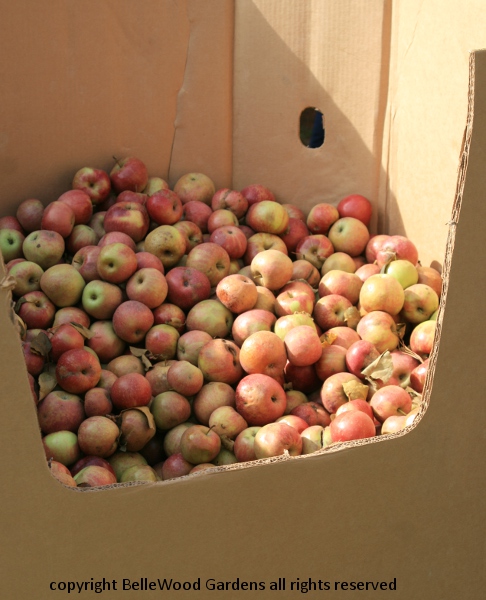
It begins with a sizable quantity of a mix of apples from Terhune Orchards in Princeton, New Jersey.
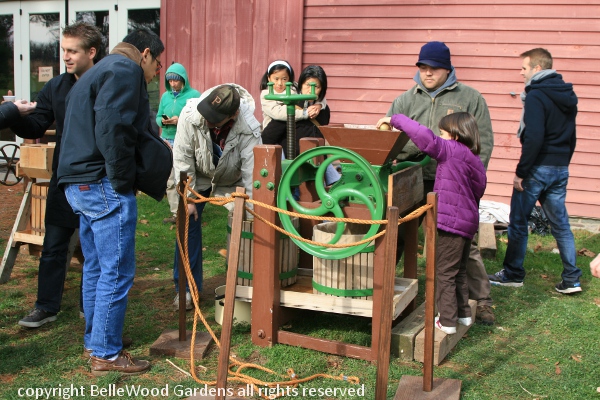
A family event, children of all ages were washing their hands, then grabbing as many apples as they could hold. They'd carry them over to the cider press and carefully toss them in to the hopper that feeds the apples into the grinder. The big green flywheel makes it easier for the children to work the crank on the other side of the hopper. A helpful adult can give the flywheel a spin, then the cranking goes more easily than starting from a stop. The slatted wooden cylinder holds a mesh bag into which the pomace (fancy term for crushed apples) drops. When the bag is full, together with the wooden cylinder it is moved from under the grinder and placed below
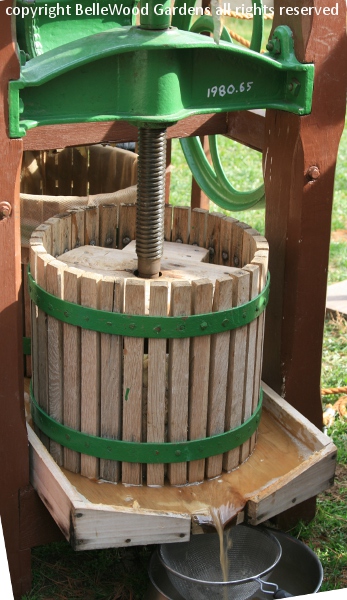
the screw press. A handle above the threaded rod is turned, forcing the wooden plate down, squeezing the pomace and releasing the cider from the pulp. As the flow of cider begins to slow, the screw rod is backed off and two thick wooden blocks are fitted above the wooden plate and below the thick rod.
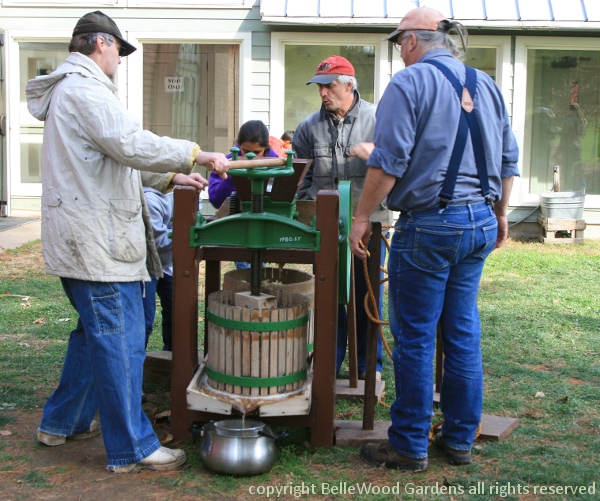
Now Reinhold has to use a lever to turn the handle and squeeze the last of the cider from the pomace. Just look at the "ciderfall" rushing in to the catch pot and sieve.
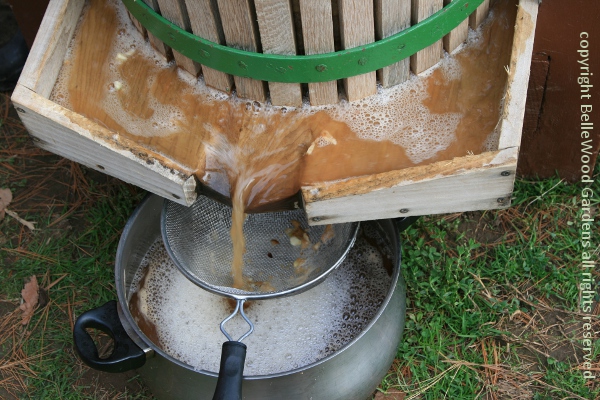
.

Next the wrung out squeezings are removed from the confining cylinder and dumped out of the mesh bag. Waste not, want not. What do you suppose happens now?
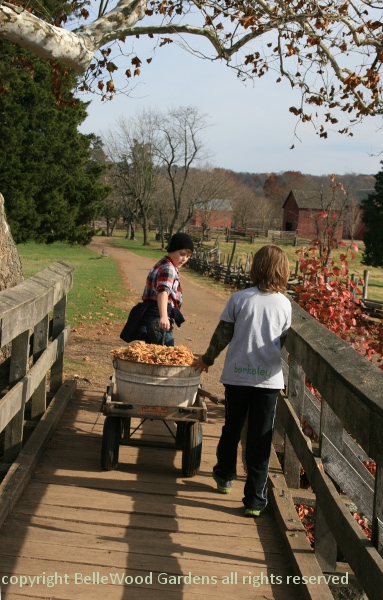
Ryan and Martin load a tub of the stuff onto a cart and go rattling over the footbridge to the barns and livestock pens. There are four pigs here at the farm . . . .
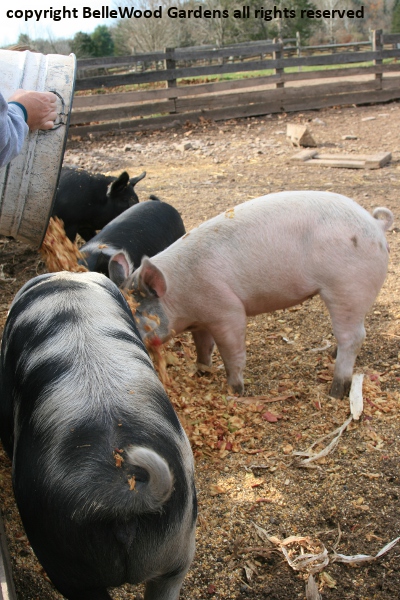
and pigs are eager eaters. As the boys were shoveling from the tub pigs were crowding in right underneath, getting the squeezed pomace on their heads. They didn't care. And when the tub was light enough to lift and dump into the pigs' food trough, why, the piggy critters were standing in it.
Reinhold said that farmers would also dump the squeezings at the edge of a field to attract deer, then hunt to get venison to feed their families.

Here are a few bottles of commercially produced hard cider
at Central Liquors on Reaville Avenue in Flemington, New Jersey.
Safer than water, hard cider was the beverage of choice in colonial America, and continued in popularity right up to the mid-1800s. Easier (and cheaper) to produce than brewing beer, or making wine making. My first introduction to hard cider was a number of years ago. I was giving a series of lectures in England and also spending time visiting some friends. Simon and Pippa drove me to North Devon where, among other places, we went to Rosemoor, a National Trust Garden. And there I had a ploughman's lunch - good bread, strong cheese, an apple, and a bottle of Tarka's Tipple English cider. My memories of the rest of the afternoon are somewhat of a blur. Most recently, just last Tuesday two friends came with me to The Cloisters. Their cafe is closed for the season so for lunch we continued north on the Henry Hudson Parkway to Wave Hill for lunch and a stroll around the gardens. And with my lunch (a salad of locally sourced rye berries with parsnips and delicata squash) I had a bottle of Cliffton Premium Dry Cider. Quite clear and pale, really showing well in the clear glass bottle. 5.5% alcohol, and very pleasant to drink.
In New York Times on-line I found this recent article about made in America hard cider.
Jane is a regular on-line visitor to BelleWood Gardens. She especially enjoys the fruit-related entries. And concerning hard cider she had this to say, "That's interesting! I've seen bottled hard cider offered at specialty shops and micro-brewery restaurants, both in Michigan and Missouri. Afraid I don't much care for it myself - any I've tasted isn't all that different from beer, as far as my uneducated palate can tell, and I don't like beer. I do enjoy our homemade cider when it sits on the counter and just starts going hard - fizzy, and a little less sweet, without much alcohol in it."
"Late to the party here but a favorite topic of mine." writes Linda, who I met at my book signing at the Frenchtown Farmers Market where she was selling her Cider Hill Orchard apples. "Cider." she notes, " We also use this word to refer to the 'hard' stuff which we make here in our basem......uh, uh, brewery! Ours is about 6% and quite dry as we use a white wine yeast for it. We are hardly pros in this area but have so enjoyed this past time. I predict that cider is definitely making a comeback." She added, "Cider is definitely an acquired taste but I have had some lovely ciders from Maine, New Hampshire and New York. And I do prefer the ones that are a bit bubbly. The fresh juice is indeed a treasure. Ours is unfiltered and unprocessed. Frozen once it is bottled from the press and it is really a different sort of experience."
Linda asked me about Harrison apple, an antique variety. I looked in my copy of A. J. Downing's splendid book, "Fruits and Fruit Trees in America" which was published in 1890, and found this information:
"New Jersey is the most celebrated cider-making district in America, and this Apple, which originated in Essex County of that State, has long enjoyed the highest reputation as a cider fruit. Ten bushels of the Apples make a barrel of cider. The tree grows thriftily and bears very large crops. Fruit medium size, ovate or roundish oblong. Skin yellow, with roughish, distinct black specks. Stalk one inch or more long. Flesh yellow, rather dry and tough, but with a rich flavor, producing a high-colored cider, of great body. The fruit is very free from rot, falls easily from the tree about the first of November, and keeps well."
I copied Jane on this, and she said, "Harrison sounds a lot like our Golden Russets! The fruit isn't popular with most folks as an eating apple because of its odd texture, sort of tough or grainy rather than crisp, and its rough, yellow and brownish, "russetted" skin. But it gives the cider a wonderful velvety body, and such sweetness that drinking cider made using only Golden Russets is almost like drinking syrup - it really needs lighter, tart apples mixed in. I'll have to look for Harrisons at my antique apple source - thanks!
"Have you ever seen Pink Pearmain? The skin is a very bright red, very waxy, and the flesh is mottled with bright pink. It's crisp, juicy, tart and full of flavor, and makes a very tasty, very colorful (intense pink!) applesauce. It ripens around mid-September."

When I'm peeling a few apples for a cobbler I use an Oxo peeler. Does a nice job.

What if you have a box of apples to peel?
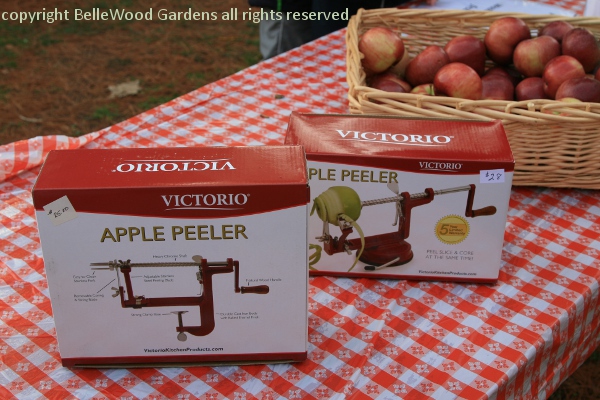
You could buy a Victorio apple peeler, either the clamp to a counter or suction base style. Or, look for one of the fascinating antique devices - It peels! It cores! It slices the apple! - that Coles Roberts demonstrated to a fascinated audience at the Howell Farm event.
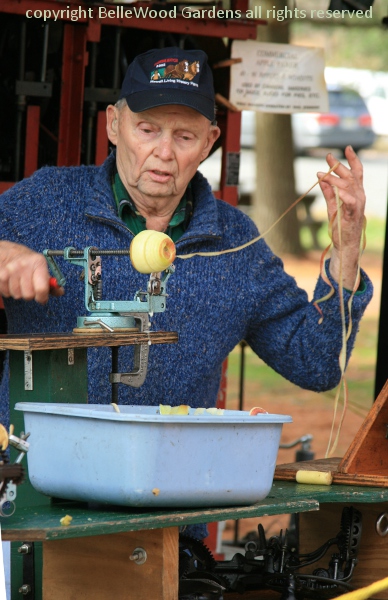
There was this somewhat modern device that takes an apple and delicately slices off the narrowest, longest peel you've ever seen.
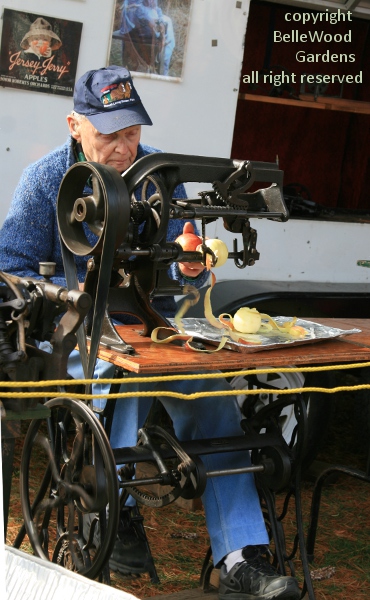
After several other hand cranked peelers Coles got to this treadle powered device that can handle two apples in sequence - if you can keep impaling a new apple as the peeled one pops off the device while the other apple is being peeled and keep it up.
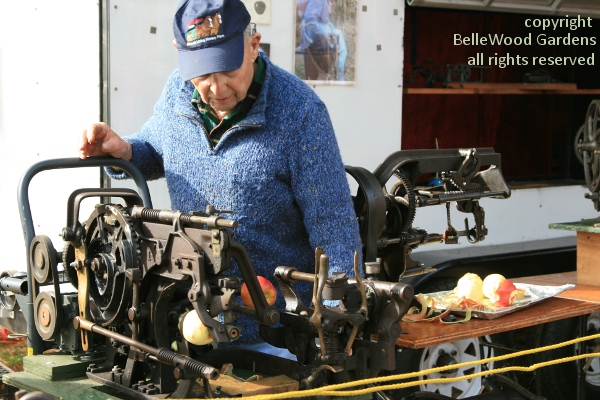
More powerful yet is this peeler that's connected to a small motor. He demonstrated an even larger, more elaborate device that peels 80 to 100 apples a minute! Similar ones are still in use today at commercial canneries, where several machines will be preparing apples around the clock, three shifts a day, when the apple harvest is in.
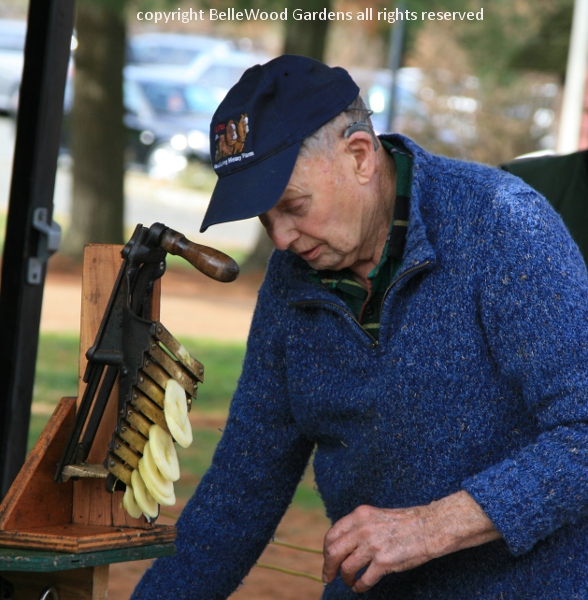
And then there was this apple slicer. Pull the lever and watch as uniform pieces drop into a basin. Good for making dried apples, I would think.

Linda makes these fabulous apple chips. For her, it's a snap. She writes,
"My oven (KitchenAid) has a dehydration setting. It's fantastic!"
Let us not forget apples for dessert (which is spelled with a pair of "s"es so you can ask for seconds) - apple cobbler, apple tart, apple pie, apple dumplings. Lisa, who bakes marvellous pies and cakes, cookies, and scones, at The Bridge Cafe in Frenchtown, New Jersey, makes scrumptious apple dumplings. Here's how she does it -

Roll out the pastry and cut into squares. Dollop on a generous scoop of filling.
This batch is made from Lodi apples.
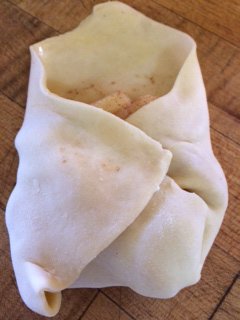
Fold up a corner, then fold in the sides. Fold down the last corner, swaddling the filling.
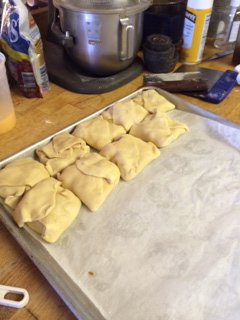
Set the newly filled dumpling on a tray with those already prepared and move on, making more. A popular iten, these apple dumplings sell well - and with good reason.
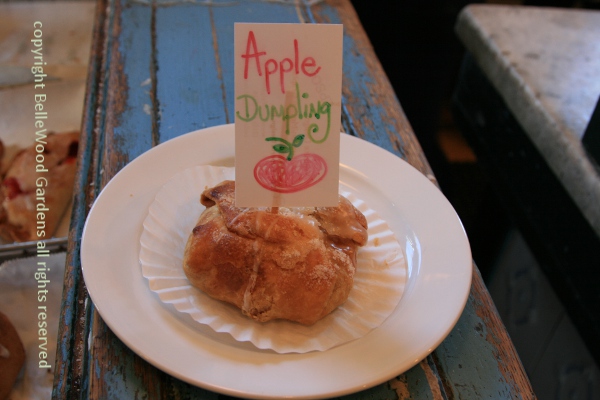
When I make apple butter, a sweet preserve, I cook the apples in cider that's been boiled down by a third or more. It gives a better flavor to the finished preserve than just water. And at Howell Living History Farm they were selling chicken in cider stew, which was very tasty. That, and a cup of hot cider made for a pleasant lunch on a brisk day.
Apples for eating. Apples for cider, fresh or fermented. Cider to drink, or to cook with. Let's hear it for the apple, deservedly popular fruit.
Back to Top
Back to November 2013